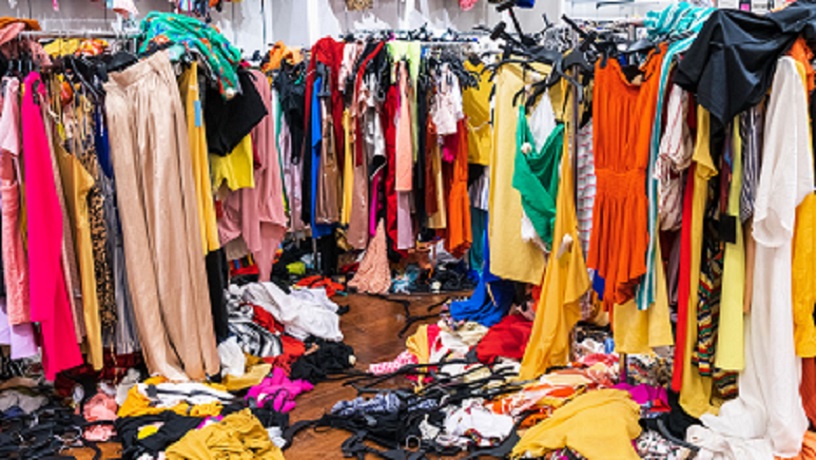Fast fashions are leading to the accumulation of unused clothing and it has a huge impact on our environment.
‘Viva Magenta’ is the colour of the year’, Broadcasts the fashion industry. It is vibrant, exuberant, and spreads joy are the words used to seduce the readers into buying wearables of this colour. Wearables of the last year’s ‘colour’ are thrown away by fashion followers. With the advent of the Free Trade Agreement, multimedia onslaught, and online sales, the fashion industry saw a Green signal to fast-track their sales. On the other hand, Mother Earth turned on a Red signal due to an overload of clothes, shoes, bags, belts, and other fashion accessories dumped on her belly. Newer, ‘smart’ wearables are already in the market, like the smart watches which need to be replaced by a better model every year. In the pipeline are smart tracker vests for footballers, socks for runners, and clothes to keep us warm or cool. All are fitted with sensors and plastics.
An average person throws away 60% of the new wearables after one year of use. 18.6 million tons of this waste finds its way to landfill every year. At this current rate, it is estimated that 150 million tons will be added to landfills by 2050. Even the textile and garment manufacturers admit that 25% is lost during their processing of yarn and tailoring. As per the World Economic Forum, $ 400 billion worth of clothes is wasted every year. Shoes and other accessories are extra. So are their packing materials. Scientists who study Green House Gases, GHG, have calculated that the fashion industry adds $ 1.2 billion tons of these Gases.
Which Wearables?
Well, almost all of us wear clothes, hats, and shoes. Add to it the belts, bags, purses, and wallets. Watches, pens, and fashion jewellery excluding expensive gold, platinum, silver, and diamond are all discarded almost every year. New ones have to be bought to keep up with the Joneses or, rather the Kardashians. Millions of dollar worth of unused PIP have been dumped in the UK and many other countries.
Implications
- As pointed out earlier, they emit Green House Gases leading to Global Warming. Wearable wastage contributed to 10% of all global carbon emissions.
- The textile industry is second only to farming in discharging toxic chemicals into our waterways. This is mostly due to the dyeing of yarns and cloth. Rotting in landfills is a second cause. One kg of clothes (averagely worn by us) pollutes 1000 litres of water in nearby waterbodies where these are manufactured or dumped. Such polluted water enters our pipelines and also seeps into the soil.
- Synthetics in our clothes came about 60 years ago as ‘wrinkle-free’ materials. Synthetic wastes of manufacturers, individuals’ clothing, and other accessories release microfibres (plastics) into the atmosphere. First, they persist in the air and soil and finally, they end up in the oceans. The microplastics added to oceans are equivalent to 50 billion plastic bottles a year.
- The leather industry has a different story which is quite sordid and would need a separate blog.
- Each kilogram of cotton needs 20,000 litres of water to produce. The farmland and the water used for cotton can be used to grow eatables that feed the hungry. Basic cotton needs can be met by just producing half the cotton but our habits of hoarding wearables of cotton are legendary.
China- A Major Contributor
For 4 reasons.
- They have the largest population.
- They manufacture the biggest amount of wearables.
- High-fashion wearables are extremely cheap leading to a very high discard rate.
- Lastly and most importantly, the Chinese have a taboo against wearing second-hand clothes. Even the financially poor Chinese people feel that ill omen will befall if they wear used clothing.

Their cities have special bins for used clothing which are always full. In recent years, many businesses have come up with the export of reused clothes that have a ‘New Look’. However, most other clothes end up in landfills. Chinese ‘used clothes’ are considered ‘cheap’ and find no international purchasers. Hence, these are first exported to the US or EU countries for relabelling. They are then re-exported to poor African countries.
Situation in India
Indians have originally been quite frugal with their wearables. Our use-till-the-clothes-wear-out and then keep using them as dusters are well known. Many adults of large families remember wearing the clothes and even shoes of their elder siblings during childhood. In fact, the newborn babies are still covered with the used clothing of the family.
Our customs and habits have changed very fast in the last decade, especially after the pandemic. Indian textile industry is one of the largest and our consumption per annum is around $68 billion. More wearables are required when more women go out to work. Band Baaja Baraat weddings need truckloads of clothes for families and friends. Increased buying power, targeted advertising, and ease of purchase (shopping from home) have led to unwanted wearables being bought at the drop of a pin.
Our wastage rate will keep increasing if such habits are not curbed early. Our large population in a small landmass means mountains of garbage next to towns and cities. Besides other things, discarded wearables are finding their way into these mountains. The poor ragpickers salvage only the reusable ones, leaving the rest to rot.
Why do we buy so many wearables?
Marketing agents of wearable manufacturers spend huge amounts researching consumer tastes, shopping attitudes, and behaviour. Haute couture diktats are religiously followed by models, actors, media-savvy achievers, and now, professional influencers. Their latest focus is on children. Children can be easily hoodwinked by smart multimedia programs. Today’s children pressurise their parents for unnecessary purchases. Adult customers are also confused with the wide range of choices.
Instinctive and spontaneous purchases are also done to uplift a sad mood. A holiday, a celebration, or even just catch ups with friends and relatives are times to indulge. Physical and hormonal influences are also at play in shopping by ladies. Clothing or shoes bought at a particular phase may not fit at another phase. Even the material’s feel or colour may not appeal at a different phase. Access to extra money or plain jealousy with a neighbour or contemporary is also the reason for spontaneous purchases which may later be regretted. This is now leading to reflation!
What can we do to reduce this wastage?
As usual, I focus on what we can do rather than what the government or manufacturers, or business houses should do. The basic principles remain the same for all wastes – REDUCE, REUSE, AND RECYCLE. Add DONATE.

REDUCE includes buying less. Not being an impulsive buyer and, preferably, buying in a store instead of ordering online. Refitting of clothes can be done by tailours but tight shoes cannot be worn. Choose material carefully that suits our body and not what the actor wore in a 2-minute advertisement.
REUSE wearables are worn by siblings or other relatives. Creative people have thousands of ideas (just Google) on how to make bags, pillows, quilts, mattresses, durries,, and blankets from old clothes. Or just alter an old dress into a new dress.
RECYCLING by means of exchanging utensils, selling to junkyards, or even composting. However, only clothes of natural fibres should be composted with kitchen waste.
DONATE to your favourite charity. Only articles that are in good condition should be donated. Woollen clothes donation walls are also set up in many North Indian towns and cities for this purpose before winter.
After reading the above, one does feel that we must buy only those wearables which we actually need. Not those that appeal to us. Together, we can save our mother – Mother Earth. This way we can hand over a better place to live to our children. We can try to postpone climate change. As yet we are only watching the trailer of flash floods, forest fires, and excessive lightning deaths. The horror movie is yet to start.
Mathew Olzmann’s ‘Letter to someone living fifty years from now speaks eloquently of how someone living in the desolate future will think how we hated our planet:

Disclaimer: The views and opinions expressed by the author do not necessarily reflect the views of the Government of India and Defence Research and Studies
Title Image Courtesy: https://www.mirabaud.com/
Article Courtesy: https://genkris.wordpress.com/








